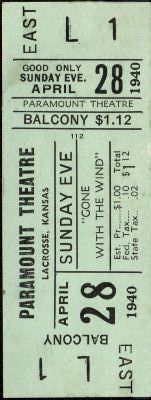The Paramount Theatre
 In 1927, Ralph and Jewell Larned moved to La Crosse from Texas. Ralph Larned had been working in the Dallas area as an agent for Paramount Studios. The week of January 19, 1930, he purchased the
opera house building and equipment from Charley Hass. By then, the opera house had been renamed the LaCrosse Theatre. On the following Saturday, Larned closed the theatre to make updates to the
building. On February 10, it reopened as the Paramount Theatre. The building had been completely remodeled. A new sound deadening ceiling was installed and lowered 12 feet. The balcony was closed
off and a larger screen was installed. A manager's office and ticket window were installed in the lobby. The most noticable improvement was the installation of new sound equipment.
In 1927, Ralph and Jewell Larned moved to La Crosse from Texas. Ralph Larned had been working in the Dallas area as an agent for Paramount Studios. The week of January 19, 1930, he purchased the
opera house building and equipment from Charley Hass. By then, the opera house had been renamed the LaCrosse Theatre. On the following Saturday, Larned closed the theatre to make updates to the
building. On February 10, it reopened as the Paramount Theatre. The building had been completely remodeled. A new sound deadening ceiling was installed and lowered 12 feet. The balcony was closed
off and a larger screen was installed. A manager's office and ticket window were installed in the lobby. The most noticable improvement was the installation of new sound equipment.
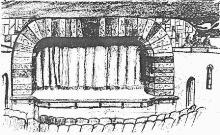 In April 1932, the theatre underwent a more extensive remodel. Exterior renovations involved bricking over many of the windows. On the front, four large upstairs windows were replaced with smaller windows while the lower windows remained unchanged. A triangular marquee bearing
the Paramount name with space for listing current attractions was suspended over the entrance. The interior of the building was designed by H. C. Benny, a nationally renowned decorator. The original design featured an Aztec decor throughout the building with
two entrances into the auditorium from the lobby, and two stairways leading into the balcony. The stage and screen area had a large multi-colored faux-stone arch flanked by Spanish-style flat roofed anterooms with arched doors and windows. (The illustration above is reproduced from Benny's original drawing.) The seating capacity,
including balcony, was 450. Opening night was a gala festivity with special invitations going out to theatre owners in neighboring towns. The feature presentation was “Dancers in the Dark” starring Miriam Hopkins, Jack Oakie, William Collier, Jr., and Eugene Pallette.
In addition, the Warner McKinley Missourians orchestra from Kansas City provided music for a spring style show sponsored by McCormick Hat Shop of La Crosse. Fifteen young ladies exhibited the latest fashions. The local girls included: Harriet Jefferies, Lillian Gisick, Barbara Robinson,
Clyta Thornhill, Blanche Wolfe, Mary Fern McMurray, Marjorie Conner, Alice Thomas, Kathleen Walker, Dorothe Greenway, Edna Hansen, and Allegra Milberger. A special dance routine was performed by Miss Courtney Jane Meredith, daughter of the Larneds.
In April 1932, the theatre underwent a more extensive remodel. Exterior renovations involved bricking over many of the windows. On the front, four large upstairs windows were replaced with smaller windows while the lower windows remained unchanged. A triangular marquee bearing
the Paramount name with space for listing current attractions was suspended over the entrance. The interior of the building was designed by H. C. Benny, a nationally renowned decorator. The original design featured an Aztec decor throughout the building with
two entrances into the auditorium from the lobby, and two stairways leading into the balcony. The stage and screen area had a large multi-colored faux-stone arch flanked by Spanish-style flat roofed anterooms with arched doors and windows. (The illustration above is reproduced from Benny's original drawing.) The seating capacity,
including balcony, was 450. Opening night was a gala festivity with special invitations going out to theatre owners in neighboring towns. The feature presentation was “Dancers in the Dark” starring Miriam Hopkins, Jack Oakie, William Collier, Jr., and Eugene Pallette.
In addition, the Warner McKinley Missourians orchestra from Kansas City provided music for a spring style show sponsored by McCormick Hat Shop of La Crosse. Fifteen young ladies exhibited the latest fashions. The local girls included: Harriet Jefferies, Lillian Gisick, Barbara Robinson,
Clyta Thornhill, Blanche Wolfe, Mary Fern McMurray, Marjorie Conner, Alice Thomas, Kathleen Walker, Dorothe Greenway, Edna Hansen, and Allegra Milberger. A special dance routine was performed by Miss Courtney Jane Meredith, daughter of the Larneds.
The theatre underwent another minor renovation in October 1941 with the installation of new seats and brightly-colored carpeting, new stage setting, repainting and redecorating. Following the war, advancements in the motion picture industry made it apparent that the theatre was due for another extensive face-lift. In January of 1946, the Paramount began temporary operations in the LaCrosse City Auditorium so that remodeling could begin in the theatre. The remodeling, touted as "the most extensive building project to be completed in LaCrosse since the close of the war," was completed in May 1946. The $25,000 remodeling (over $300,000 in today's dollar) entailed a complete remake of the building. The facility was designed by Robert O. Boller, nationally renowned theatre architect. Charles and O.L. Jones of LaCrosse were the contractors.
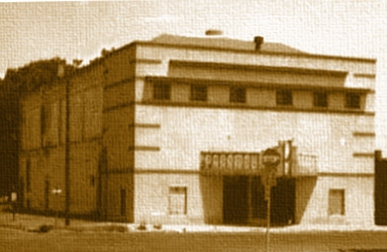 The entrance of the building was lowered to street level with a box-office built of glass block. A novel
feature of the theatre was a "cry-room" with piped-in sound to allow parents with babies to enjoy the show
without disturbing other patrons. A refreshment bar served from both the lobby and foyer. Sound and projection
equipment were some of the finest available. The front exterior was covered in buff stucco with chocolate-brown
trim. The art deco style main room was finished in dusty pink accented with burgundy wainscoting. Burgundy,
blue, and gold draperies framed a screen thirty feet wide. The main room seated 350 patrons in red velvet orchestra
seats. The balcony seated an additional 174 patrons. To add to patrons' comfort, the entire building was heated
and air-conditioned. The first show in the newly- remodeled theatre was "The Harvey Girls" starring Judy Garland,
John Hodiak, and Ray Bolger.
The entrance of the building was lowered to street level with a box-office built of glass block. A novel
feature of the theatre was a "cry-room" with piped-in sound to allow parents with babies to enjoy the show
without disturbing other patrons. A refreshment bar served from both the lobby and foyer. Sound and projection
equipment were some of the finest available. The front exterior was covered in buff stucco with chocolate-brown
trim. The art deco style main room was finished in dusty pink accented with burgundy wainscoting. Burgundy,
blue, and gold draperies framed a screen thirty feet wide. The main room seated 350 patrons in red velvet orchestra
seats. The balcony seated an additional 174 patrons. To add to patrons' comfort, the entire building was heated
and air-conditioned. The first show in the newly- remodeled theatre was "The Harvey Girls" starring Judy Garland,
John Hodiak, and Ray Bolger.
 The Larneds operated the Paramount until the late 1960s when the popularity of television began to force
many community theatres out of business. In 1971, Sterling and Steve Bagby reopened the theatre on weekends. The Bagby's,
who operated a chain of theatres and drive-ins had recently reopened the local drive-in theatre. The Paramount survived for
another season, before being permanently closed. In 1973, the main floor seats were placed in the new livestock sale barn north of LaCrosse.
In 1974, the theatre had a brief moment in the spotlight when it used for exterior shots in the filming of the
short-lived television series, "Paper Moon."
The Larneds operated the Paramount until the late 1960s when the popularity of television began to force
many community theatres out of business. In 1971, Sterling and Steve Bagby reopened the theatre on weekends. The Bagby's,
who operated a chain of theatres and drive-ins had recently reopened the local drive-in theatre. The Paramount survived for
another season, before being permanently closed. In 1973, the main floor seats were placed in the new livestock sale barn north of LaCrosse.
In 1974, the theatre had a brief moment in the spotlight when it used for exterior shots in the filming of the
short-lived television series, "Paper Moon."
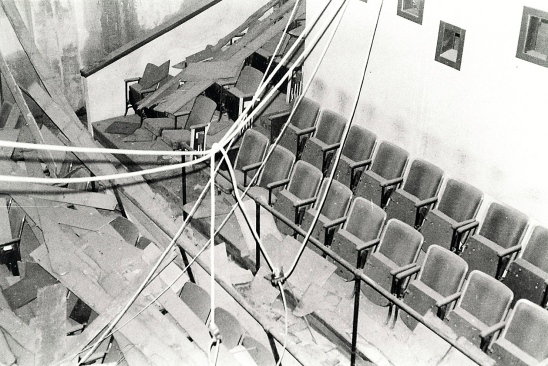 In the mid 1970s, many historic downtown theatres were abandoned as owners of the aging buildings were faced with soaring maintenance
costs, smaller crowds, and limitations of a single screen. Smaller multiplex cinemas were more economical to maintain and offered movie-goers
multiple movie options at the same time. With the community's declining population, it became apparent the building would never again
be used to show movies. The Farmers & Merchants State Bank of La Crosse, who had taken ownership of the building a few years prior, attempted
to find a new use for the building but were not successful.
In the mid 1970s, many historic downtown theatres were abandoned as owners of the aging buildings were faced with soaring maintenance
costs, smaller crowds, and limitations of a single screen. Smaller multiplex cinemas were more economical to maintain and offered movie-goers
multiple movie options at the same time. With the community's declining population, it became apparent the building would never again
be used to show movies. The Farmers & Merchants State Bank of La Crosse, who had taken ownership of the building a few years prior, attempted
to find a new use for the building but were not successful.
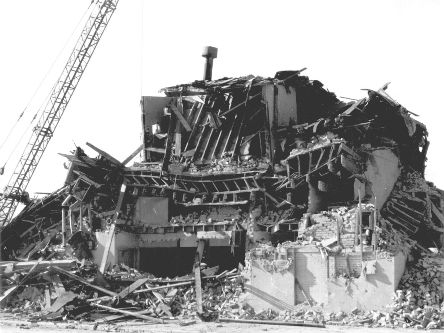 Over the next few years, time and neglect began to take their toll on the once beautiful facility. For safety reasons,
the faded marquee, which had begun to sag, was removed and broken box office windows were covered. Although the projection equipment
had been removed years before, the balcony seats, curtains, and screen were left to deteriorate beneath the leaking roof. The
building continued in use as a warehouse until early 1981. In April, the 70-year-old theatre was razed to make room for a parking lot.
Unfortunately, the theatre did not survive long enough to experience a “rebirth” as did so many others during the resurgence of downtown movie palaces
that started in the late 1980s.
Over the next few years, time and neglect began to take their toll on the once beautiful facility. For safety reasons,
the faded marquee, which had begun to sag, was removed and broken box office windows were covered. Although the projection equipment
had been removed years before, the balcony seats, curtains, and screen were left to deteriorate beneath the leaking roof. The
building continued in use as a warehouse until early 1981. In April, the 70-year-old theatre was razed to make room for a parking lot.
Unfortunately, the theatre did not survive long enough to experience a “rebirth” as did so many others during the resurgence of downtown movie palaces
that started in the late 1980s.
